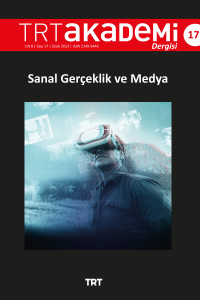Öz
Anahtar Kelimeler
Sanal Gerçeklik Gerçeklik Sistemleri İnsan Merkezli Etkileşim Sinema Suretler Filmi
Destekleyen Kurum
Destekleyen Kurum Yoktur.
Teşekkür
Sayın editör, değerli vaktinizi ayırdığınız için teşekkür eder, çalışmlarınızda kolaylıklar dileriz.
Kaynakça
- Aczél, P. (2017). Beyond Persuasion -Rhetoric in a Virtual World. p. 29-40. in Virtual Reality- Real Visuality: Virtual, Visual, Veridical. (Eds.) András Benedek and Ágnes Veszelszki. NY: Peter Lang Publications.
- Akmeşe, E. ve Akmeşe, Z. (2020). Mizahla Estetize Edilen Egemen İdeolojinin Tezahürü: Muhsin Bey. Sosyal, Beşeri ve İdari Bilimler Dergisi. 3(3). s.194-207
- Bolat, N. (2021). Televizyon Programcılığında Dijital Platformlarla Dönüşen İzleyici. s.187- 208. içinde Dijitalleşme Ekseninde İletişim, Kültür ve Medya. (Ed.) İbrahim Halil Yaşar. Konya: Literatürk Academia.
- Chan, M. (2014). Virtual Reality Representations in Contemporary Media. NY: Bloomsburry Academic
- Craig, A. B., Sherman, W. R. and Will, J. D. (2009). Developing Virtual Reality Applications: Foundations of Effective Design. NY: Elsevier.
- Disneyplus (2022). https://www.disneyplus.com/tr-tr/movies/suretler/4lZHfSGbNf6P [Erişim Tarihi: 13.10.2022].
- Jerald, J. (2016). The VR Book: Human-Centered Design for Virtual Reality. Illinois: ACM Books
- Julca, F., Méndez, G. and Hervás, R. (2020). An Internal Model for Characters in Virtual Environments: Emotions, Moods and Personality. p.91-117. in Virtual Reality Designs. (Eds.) Adriana Peña Pérez Negrón, Graciela Lara López and Héctor Rafael Orozco Aguirre. NY: CRC Press, Taylor & Francis Group
- Kim, G. J. (2005). Designing Virtual Reality Systems: The Structured Approach. London: Springer
- Örüm, E. ve Demir, Ö. (2021). Bilimkurgu Film Türünde Karakter Kimlikliklerinin İnşasında Bellek ve Zaman Olgularının Kullanımı: Blade Runner Filmleri Örneği. Sanat Dergisi. (37). s.200-214.
- Postman, N. (2013). Teknopoli: Kültürün Teknolojiye Teslim Oluşu. (Çev.) Mustafa EmreYılmaz. Bursa: Sentez Yayıncılık
- Ryan, J. (2019). İnternetin Geçmişi ve Dijital Gelecek. (Çev.) Birsen Keleş. Ankara: TUBİTAK Yayınları.
- Taşdelen, V. (2016). İnsan Açısından Teknoloji. Hece. Yıl 20. Sayı 234-235-236. s.38-44.
- Ünal, H. (2016). Dijital Kültürün Ortaya Çıkardığı Korkularımız ve Sanalın Karşıtına Dönüşerek Hakikileşmesi. Hece. Yıl 20. Sayı 234-235-236. s.32-37.
- Volland, H. (2022). Makinelerin Yaratıcı Gücü: Gelecekte Duygularımızı ve Düşüncelerimizi Yapay Zekâ mı Belirleyecek? (Çev.) S. Türkis Noyan. İstanbul: Orenda Yayıncılık
- Williams, R. (2005). Anahtar Sözcükler: Kültür ve Toplumun Sözvarlığı. (Çev.) Savaş Kılıç. İstanbul: İletişim Yayınları.
- Yengin, D. ve Bayrak, T. (2017). Sanal Gerçeklik. İstanbul: Der Yayınları.
Öz
Anahtar Kelimeler
Virtual Reality Realty Systems Human-Centered Interaction Cinema Surrogates Film
Kaynakça
- Aczél, P. (2017). Beyond Persuasion -Rhetoric in a Virtual World. p. 29-40. in Virtual Reality- Real Visuality: Virtual, Visual, Veridical. (Eds.) András Benedek and Ágnes Veszelszki. NY: Peter Lang Publications.
- Akmeşe, E. ve Akmeşe, Z. (2020). Mizahla Estetize Edilen Egemen İdeolojinin Tezahürü: Muhsin Bey. Sosyal, Beşeri ve İdari Bilimler Dergisi. 3(3). s.194-207
- Bolat, N. (2021). Televizyon Programcılığında Dijital Platformlarla Dönüşen İzleyici. s.187- 208. içinde Dijitalleşme Ekseninde İletişim, Kültür ve Medya. (Ed.) İbrahim Halil Yaşar. Konya: Literatürk Academia.
- Chan, M. (2014). Virtual Reality Representations in Contemporary Media. NY: Bloomsburry Academic
- Craig, A. B., Sherman, W. R. and Will, J. D. (2009). Developing Virtual Reality Applications: Foundations of Effective Design. NY: Elsevier.
- Disneyplus (2022). https://www.disneyplus.com/tr-tr/movies/suretler/4lZHfSGbNf6P [Erişim Tarihi: 13.10.2022].
- Jerald, J. (2016). The VR Book: Human-Centered Design for Virtual Reality. Illinois: ACM Books
- Julca, F., Méndez, G. and Hervás, R. (2020). An Internal Model for Characters in Virtual Environments: Emotions, Moods and Personality. p.91-117. in Virtual Reality Designs. (Eds.) Adriana Peña Pérez Negrón, Graciela Lara López and Héctor Rafael Orozco Aguirre. NY: CRC Press, Taylor & Francis Group
- Kim, G. J. (2005). Designing Virtual Reality Systems: The Structured Approach. London: Springer
- Örüm, E. ve Demir, Ö. (2021). Bilimkurgu Film Türünde Karakter Kimlikliklerinin İnşasında Bellek ve Zaman Olgularının Kullanımı: Blade Runner Filmleri Örneği. Sanat Dergisi. (37). s.200-214.
- Postman, N. (2013). Teknopoli: Kültürün Teknolojiye Teslim Oluşu. (Çev.) Mustafa EmreYılmaz. Bursa: Sentez Yayıncılık
- Ryan, J. (2019). İnternetin Geçmişi ve Dijital Gelecek. (Çev.) Birsen Keleş. Ankara: TUBİTAK Yayınları.
- Taşdelen, V. (2016). İnsan Açısından Teknoloji. Hece. Yıl 20. Sayı 234-235-236. s.38-44.
- Ünal, H. (2016). Dijital Kültürün Ortaya Çıkardığı Korkularımız ve Sanalın Karşıtına Dönüşerek Hakikileşmesi. Hece. Yıl 20. Sayı 234-235-236. s.32-37.
- Volland, H. (2022). Makinelerin Yaratıcı Gücü: Gelecekte Duygularımızı ve Düşüncelerimizi Yapay Zekâ mı Belirleyecek? (Çev.) S. Türkis Noyan. İstanbul: Orenda Yayıncılık
- Williams, R. (2005). Anahtar Sözcükler: Kültür ve Toplumun Sözvarlığı. (Çev.) Savaş Kılıç. İstanbul: İletişim Yayınları.
- Yengin, D. ve Bayrak, T. (2017). Sanal Gerçeklik. İstanbul: Der Yayınları.
Ayrıntılar
| Birincil Dil | Türkçe |
|---|---|
| Konular | İletişim ve Medya Çalışmaları |
| Bölüm | Makaleler |
| Yazarlar | |
| Yayımlanma Tarihi | 31 Ocak 2023 |
| Gönderilme Tarihi | 20 Kasım 2022 |
| Kabul Tarihi | 23 Ocak 2023 |
| Yayımlandığı Sayı | Yıl 2023 Cilt: 8 Sayı: 17 |
Cited By
Din ve Teknoloji Etkileşiminde Yapay Zeka ve Transhümanizm’e Yaklaşımlar
Pamukkale Üniversitesi İlahiyat Fakültesi Dergisi
https://doi.org/10.17859/pauifd.1267034
This work is licensed under Creative Commons Attribution-NonCommercial-NoDerivatives 4.0 International


